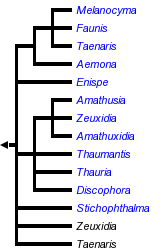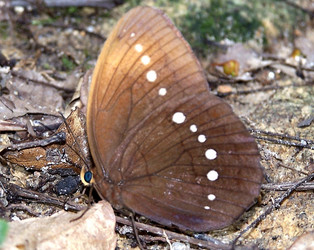Amathusiini
Niklas Wahlberg and Andrew V. Z. Brower


This tree diagram shows the relationships between several groups of organisms.
The root of the current tree connects the organisms featured in this tree to their containing group and the rest of the Tree of Life. The basal branching point in the tree represents the ancestor of the other groups in the tree. This ancestor diversified over time into several descendent subgroups, which are represented as internal nodes and terminal taxa to the right.

You can click on the root to travel down the Tree of Life all the way to the root of all Life, and you can click on the names of descendent subgroups to travel up the Tree of Life all the way to individual species.
For more information on ToL tree formatting, please see Interpreting the Tree or Classification. To learn more about phylogenetic trees, please visit our Phylogenetic Biology pages.
close boxDiscussion of Phylogenetic Relationships
Corbet et al. (1992) state that Faunis, Melanocyma and Taenaris "form a natural group probably worthy of subtribal rank ... ." This hypothesis is supported by preliminar molecular results (Peña et al. 2006, Wahlberg & Brower unpubl.). Hyantis and Morphopsis, two New Guinean genera traditionally included in Amathusiini, appear to be associated instead with Elymniiini. Note that Xanthataenia is not an amathusiine. This was pointed out by Corbet et al. (1992) on the basis of larval morphology, and has been corroborated by molecular evidence (Wahlberg & Brower, unpubl.).
References
Corbet AS, Pendlebury HM, and Eliot JN. 1992. The butterflies of the Malay Peninsula. Malayan Nature Society, Kuala Lumpur.
Parsons M. 1999. The butterflies of Papua New Guinea: their systematics and biology. Academic Press, San Diego.
Pena C, and Lamas G. 2005. Revision of the butterfly genus Forsterinaria Gray, 1973 (Lepidoptera: Nymphalidae, Satyrinae). Revista Peruana de Biologia 12: 5-48.
Title Illustrations

| Scientific Name | Faunis eumeus |
|---|---|
| Location | Hong Kong |
| Acknowledgements |
This image is
licensed under the Attribution-ShareAlike 2.0 Creative Commons License. source: flickr: Old Friend Again |
| Specimen Condition | Live Specimen |
| Copyright | © 2005 Charles Lam |
About This Page
Niklas Wahlberg

Stockholm University, Stockholm, Sweden

Middle Tennessee State University, Murfreesboro, Tennessee, USA
Correspondence regarding this page should be directed to Niklas Wahlberg at and Andrew V. Z. Brower at
Page copyright © 2006 Niklas Wahlberg and
- First online 25 September 2006
- Content changed 09 November 2006
Citing this page:
Wahlberg, Niklas and Brower, Andrew V. Z. 2006. Amathusiini. Version 09 November 2006 (under construction). http://tolweb.org/Amathusiini/70273/2006.11.09 in The Tree of Life Web Project, http://tolweb.org/







 Go to quick links
Go to quick search
Go to navigation for this section of the ToL site
Go to detailed links for the ToL site
Go to quick links
Go to quick search
Go to navigation for this section of the ToL site
Go to detailed links for the ToL site